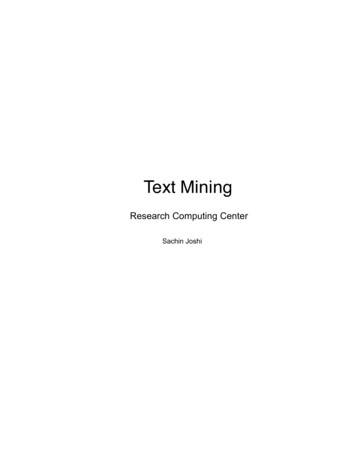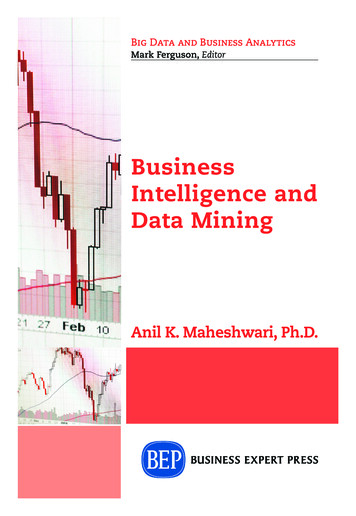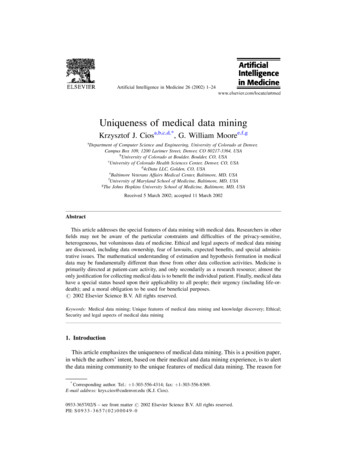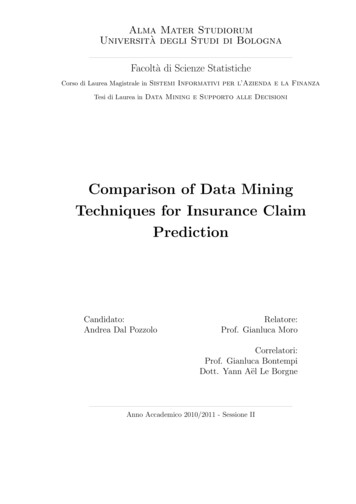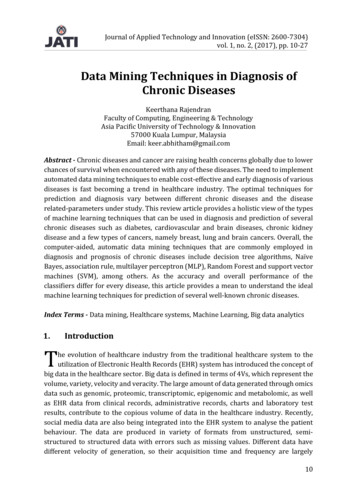
Transcription
Journal of Applied Technology and Innovation (eISSN: 2600-7304)vol. 1, no. 2, (2017), pp. 10-27Data Mining Techniques in Diagnosis ofChronic DiseasesKeerthana RajendranFaculty of Computing, Engineering & TechnologyAsia Pacific University of Technology & Innovation57000 Kuala Lumpur, MalaysiaEmail: keer.abhitham@gmail.comAbstract - Chronic diseases and cancer are raising health concerns globally due to lowerchances of survival when encountered with any of these diseases. The need to implementautomated data mining techniques to enable cost-effective and early diagnosis of variousdiseases is fast becoming a trend in healthcare industry. The optimal techniques forprediction and diagnosis vary between different chronic diseases and the diseaserelated-parameters under study. This review article provides a holistic view of the typesof machine learning techniques that can be used in diagnosis and prediction of severalchronic diseases such as diabetes, cardiovascular and brain diseases, chronic kidneydisease and a few types of cancers, namely breast, lung and brain cancers. Overall, thecomputer-aided, automatic data mining techniques that are commonly employed indiagnosis and prognosis of chronic diseases include decision tree algorithms, NaïveBayes, association rule, multilayer perceptron (MLP), Random Forest and support vectormachines (SVM), among others. As the accuracy and overall performance of theclassifiers differ for every disease, this article provides a mean to understand the idealmachine learning techniques for prediction of several well-known chronic diseases.Index Terms - Data mining, Healthcare systems, Machine Learning, Big data analyticsIntroductionThe evolution of healthcare industry from the traditional healthcare system to theutilization of Electronic Health Records (EHR) system has introduced the concept ofbig data in the healthcare sector. Big data is defined in terms of 4Vs, which represent thevolume, variety, velocity and veracity. The large amount of data generated through omicsdata such as genomic, proteomic, transcriptomic, epigenomic and metabolomic, as wellas EHR data from clinical records, administrative records, charts and laboratory testresults, contribute to the copious volume of data in the healthcare industry. Recently,social media data are also being integrated into the EHR system to analyse the patientbehaviour. The data are produced in variety of formats from unstructured, semistructured to structured data with errors such as missing values. Different data havedifferent velocity of generation, so their acquisition time and frequency are largely10
Journal of Applied Technology and Innovation (eISSN: 2600-7304)vol. 1, no. 2, (2017), pp. 10-27varied. Moreover, these data are obtained from diverse sources whose reliability is notauthenticated (Raghupathi & Raghupathi, 2014; Auffray et al., 2016). By employing datamining methods into big healthcare data (BHD), several patients can be assessed at thesame time and better care can be given based on improved understanding of patientmedical profile. Some of the benefits of applying data mining in healthcare are as follows(Durairaj & Ranjani, 2013): Optimized management of hospital resources Better understanding of patients to improve customer relation Detection of fraud and abuses found in insurance and medical claims Control the widespread of hospital infections and identify high-risk patients Enhanced patient care and treatments through healthcare decision support systemData mining is defined as the process of identifying unknown patterns, relationshipsand potentially valuable information from huge datasets with the use of statistical andcomputational approaches. The primary tasks of data mining are to build predictive anddescriptive models as illustrated in Figure 1 (Durairaj & Ranjani, 2013). Data miningtechniques that are used commonly in healthcare include classification, decision tree, kNearest Neighbour (k-NN), support vector machine (SVM), neural network, Bayesianmethods, regression, clustering, association rule mining and Apriori algorithm. Thesemachine learning techniques are helpful in assessing the risk factors such associoeconomic and environmental behaviour of individuals besides their medicalprofiles in diseases, especially chronic illnesses and cancer (Tomar & Agarwal, 2013; Dey& Rautaray, 2014; Ahmad, Qamar & Rizvi, 2015).Figure1: Predictive and descriptive data mining techniques (Durairaj & Ranjani, 2013)This review article focuses on the application of data mining techniques in chronicdiseases, with a central focus on different cancer subtypes. The sections are segmentedas follows: Section 2 highlights the importance of data analytics in healthcare in general,the current trends of data analytics and some of the data mining methods used in health11
Journal of Applied Technology and Innovation (eISSN: 2600-7304)vol. 1, no. 2, (2017), pp. 10-27informatics. Section 3 elucidates on the existing data mining techniques used inidentification of most known chronic diseases such as diabetes disorder, cardiovasculardisease, brain disorder and chronic kidney disease (CKD). Each of these disease isexplained as a sub-section of Section 3. Section 4 converges its attention to theemployment of machine learning techniques in diagnosis, prognosis and prediction ofvarious cancer types which are breast cancer, lung cancer and brain cancer, divided intosub-sections. Section 5 discusses the overall review of the involvement of data miningapproaches in chronic diseases and cancer in terms of their limitations and benefits.Section 6 is the conclusion which provides an insight on the challenges of machinelearning application in healthcare industry.Data Analytics in HealthcareData analytics has a profound use in healthcare, especially in machine learning for theapplication of descriptive, prescriptive and predictive analytics. Medical data sourceranges from EHR, genomic profiles to administrative and financial data, resulting insurplus of data which require extensive application of data mining algorithms to extractvaluable output and make informed clinical decisions. In healthcare, the key function ofdata mining techniques involves the determination of rates of mortality due to diseaserisk factors and forecast of diseases at an early stage. In a book chapter by Hersh (2017),employment of data-driven measures for diagnosis and tailored treatment of diseases inprecision medicine have also been highlighted. Genome-wide association studies (GWAS)incorporates genomic data into the EHR to identify disease disorders and obtain genomelevel information. This information is processed and transformed into structuredformats for computational analysis using statistical techniques and machine learningalgorithms which results in insights gained from the disease prediction models.Inevitably analytics in healthcare data comes with several barriers such asmisinterpretation of the transformed data due to coding leading to false positive resultsand ethical issues raised on the privacy and security of personal data as well as the rightsof data access and sharing.Another review article by Raghupathi & Raghupathi (2014) has carried a similarview point on the involvement of big data in healthcare along with its benefits andfeatures, and conceptual frameworks and tools for data analytics used in healthcare. Thevast amount of data generated in various structures and formats are growingexponentially and inability to detect accuracy of these data call in for the need of big dataanalytics in healthcare. Focusing more into the benefits of data mining in healthcare, theauthors highlighted that data analytics can curtail the cost of treatment and diagnosis ofpatients, reduce trial and error practice in clinical trials by using data analytical tools andalgorithms, estimate population health trends, recognize patients who are prone for readmission, mitigate fraudulence and misuse, enable real-time update of patientconditions and perform genome-based analytics for precision medicine. The12
Journal of Applied Technology and Innovation (eISSN: 2600-7304)vol. 1, no. 2, (2017), pp. 10-27architectural skeleton highlighted how multitude of data obtained from various sourcesin a raw form can be placed in a data warehouse to allow data transformation. Thesetransformed data then go into a selection of tools/platforms for applied analytics.Hadoop is a prominent platform to analyse and process big data. Steps involved to applybig data analytics in healthcare are conception of project, manifestation of proposal,implementation of methods such as data compilation and processing, and lastly,deployment of the results. Obstacles such as privacy, data security, real-time dataevaluation, quality and governance regarding big healthcare data should be brought tolight.The article by Dinov (2016) showcased the possible techniques to conquer thesebarriers so that convoluted data can be transformed into comprehensible format foranalysis. To achieve an automatically processed decision, quantitative and structuredformat of BHD are vital. To derive statistically valuable data, some measures that can beused include visual mining, text analytics, information retrieval, data standardization andpredictive modeling markup language (PMML) to interpret and analyse medicalinformation. Social network analytics, which can be displayed in terms of nodes andedges, are used to identify relationships and patterns in the datasets. Multitudetechniques such as k-NN, Gaussian mixture modeling (GMM) as well as un-supervised,semi-supervised supervised machine learning algorithms are utilized to segment, groupand organize complex data. Incomplete records which might have missing valuesoccurring at random or not random can be handled via logistic regression. Exploratoryand explanatory analyses can be used to analyse and display incongruent data usingcloud-based dashboards. Along this, predictive analytics is the crucial task of data miningin BHD. Programming languages such as SQL and NoSQL besides cloud computing areadvances to refine BHD. Open-source platforms like Apache, Hadoop, MapReduce andSpark are freely accessible to analyse large data in the healthcare sector.As healthcare information are known to exist in copious amount, it is necessary toconstruct a standardized series of steps to analyse these data and interpret them intoknowledgeable output. A well-accepted process that is followed in healthcare datamining is Knowledge Discovery (KDD) which involves the interpretation of large volumeof data and identifying a pattern in the data to attain an insight that improves decisionmaking, as shown in Figure 2 (Ahmad, Qamar & Rizvi, 2015). In KDD, selection of targetdata from the database is the first step, followed by data pre-processing where anyunwanted data are filtered and the noisy data are eliminated. The raw and unstructureddata are then transformed into a structured format for analysis. Data mining is the keyprocess in KDD which involves descriptive and predictive analytics incorporatingnumerous algorithms and statistical measures to discover trends and build predictionmodels. Data mining is primarily assigned to carry out two approaches known as staticend-point prediction and temporal data mining which consists of classification,regression, association rule learning, cluster analysis, hidden Markov model (HMM) andtemporal association rule mining (TARM) on the transformed datasets. The interpreted13
Journal of Applied Technology and Innovation (eISSN: 2600-7304)vol. 1, no. 2, (2017), pp. 10-27outcomes allow informed decision-making. Examples of data mining application inhealthcare are artificial neural network of human brain, besides decision tree and nearestneighbour for classification and prediction. In precision medicine, genomic dataincorporated into the EHR were analysed using clustering to identify cancer subtypesand provide tailored treatments (Taranu, 2015; Wu et al., 2017).Figure 2: KDD Process (Ahmad, Qamar & Rizvi, 2015)Application of computational knowledge in healthcare is called health informaticswhich is transpiring into a demanding field requiring data experts due to the evolutionof big data in healthcare. Within this field, there are several subdomains such asbioinformatics, medical image informatics, clinical informatics and public healthinformatics which employs various levels of data generation from molecular, tissue,patient and population level data. These data are utilized to address the researchquestions posed in order to find answers for clinical, human biological and epidemicqueries. Herland, Khoshgoftaar & Wald (2014) have elucidated on the various datamining techniques applied at each data levels in health informatics. At molecular level,patient cancer gene expression profiles were analysed to group leukaemia sub-types andto forecast the recurrence of colorectal cancer (CRC) among the subjects at the initialphase using classification and support vector machines (SVM) techniques. Tissue levelinvolve methods like feature abstraction and selection applied on highly dimensionalhuman brain images and MRI of brain tissue samples to develop an extensive neuralnetwork. Besides, Fuzzy Decision Tree (FDT) and classification were used to predict theoccurrence of Alzheimer’s disease at distinct stages. The third level uses the patientrecords tested using various scoring systems under classification technique and logisticregression to build prediction models for patient readmission rate, fatality estimate andlife span of patient. Moreover, Alternating Decision Tree (ADT) and Principal ComponentAnalysis (PCA) were also used for prediction based on patients’ physiological14
Journal of Applied Technology and Innovation (eISSN: 2600-7304)vol. 1, no. 2, (2017), pp. 10-27parameters, derived from EHR. At population level, text analytics were employed onsocial media data such as Twitter, internet search engines and messaging applications toprovide patients with facts on illnesses. Real-time epidemics tracking and prognosis of apopulation health were determined using data mining techniques such as decision trees,SVM, Naïve Bayesian and logistic regression analysis.Data Mining in Chronic Diseases IdentificationThe current trends in data mining field that are available to diagnose different chronicdiseases that are the common causes of death worldwide such as diabetes,cardiovascular disease, brain disease and chronic kidney disease are illuminated in thissection.3.1 Diabetes DisorderDiabetes mellitus is a condition where the body is unable to produce sufficient insulin,resulting in increased blood sugar level. Various risk factors contribute to diabetes whichcan be used as measures to predict diabetes. The article by Renuka Devi & Maria Shyla(2016) highlighted on diabetes mellitus discussed various data mining algorithms usedon the Pima Indian Diabetes Dataset to determine the occurrence of diabetes. The datawas cleaned to eliminate noise and replace missing instances. A total of six physiologicalvariables were used to diagnose type 1 and type 2 diabetes, besides gestational diabetes.Some of the techniques used to classify the diabetes-related attributes include NaïveBayes, Random Forest, Modified J48 Classifier, SVM, k-NN, genetic algorithm, etc.Software tools such as Weka, MATLAB, Tanagara, RapidMiner, etc. were used to performdata analytics operations containing all the machine learning techniques and statisticalalgorithms. Upon comparison across all the techniques, it was found that the highestprediction accuracy of 99.87% was achieved using Modified J48 Classifier with the aid ofWeka and MATLAB tool.Another study on type 2 diabetes mellitus by Hu et al. (2016) explained thatimpaired glucose tolerance (IGT) is a causative factor of this disease as well asatherosclerosis which can lead to cardiovascular disease. Hence, data mining techniqueswere employed to identify the patterns among IGT patients with an elevated risk ofatherosclerosis. ACT NOW, a clinical trial dataset, was used as the training dataset whereit was processed using imputation and categorical attributes were created for thedisparate variables. First, feature selection using Fisher score was assigned to choose theattributes with most significance. Probabilistic Bayesian classifiers were used to generatethe prediction model which has been proven to work well on small-scale, multimodaltraining and test datasets in other reported studies. Two more classification techniquesknown as multilayer perceptron (MLP) and random forest (RF) were adopted to comparethe accuracy of the prediction, which was determined using Brier score and receiver15
Journal of Applied Technology and Innovation (eISSN: 2600-7304)vol. 1, no. 2, (2017), pp. 10-27operating characteristic curve (AUC). The best predictor was found to be the Naïve Bayeswith feature selection holding a better performance with 89.23% accuracy in comparisonto the other two approaches with about 88% accuracy level each. Naïve Bayes techniqueproved to enable the determination and prognosis of IGT subjects who encounter rapidprogression of atherosclerosis.3.2Cardiovascular DiseaseHeart disease is one the most common chronic diseases that causes fatality in adults.Heart disease prediction and their risk factors analyses have been reported in severalarticles using machine learning algorithms such as SVM, decision tree, genetic algorithm,neural networks, Naïve Bayesian classifiers and Iterative Dichotomized 3 (ID3). But,association rule technique in cardiovascular disease prognosis has been barely explored.Hence, Khare & Gupta (2016) have incorporated association rule into their study toidentify heart disease risk factors. The data was obtained from UCI open data repository.Training dataset was prepared by removing the missing observations and shortlistingthe key attributes that are related to the analysis. The numerical attributes werenominalized to categorical attributes since Apriori algorithm of the association rulemining was used. This algorithm utilized candidate generation approach to discover therecurring (frequent) variable set. Rules were generated based on the presence of heartdisease by focusing on the causative determinants for this disease, where classificationassociation rules (CAR) were applied. Accuracy of the rule was validated in the trainingstage. The schematic representation of association rule method is shown in Figure 3. Theresults showed at least 85% confidence for all the rules generated. Attributes such asgender (male), older generation, increased serum cholesterol level, presence ofasymptomatic chest pain and defective thalassemia are associated with the exposure toheart disease. While blood sugar level, an indirect measure of diabetes, was found to benegatively correlated to heart disease. This technique was found to be useful in focusingonly on the primary risk factors of heart disease, which enables cost-effective diagnosisand time-efficient treatments.16
Journal of Applied Technology and Innovation (eISSN: 2600-7304)vol. 1, no. 2, (2017), pp. 10-27Figure 3: Association rule technique (Khare & Gupta, 2016)3.3Brain DiseaseOne of the well-known type of dementia among older people is Alzheimer’s disease (AD).This neurodegenerative illness is one of the primary causes of fatality in the USA. Besidesother external factors such as lifestyle and medical circumstances, genetic factors appearto have greater influence in the progression of AD. A study was conducted by Kumar &Singh (2016) to determine the participation of AD-related genes in the pathogenicpathway and diagnosis using decision tree method. The AD gene datasets were obtainedfrom several online repositories and 2111 genes significant to the disease were selected.Feature selection of the variables were done using Chi-squared attribute evaluation andgain ratio (GR) methods. J48 algorithm found in Weka and C4.5 algorithm enabled inRapidMiner were used to achieve classification of the dataset and clustering of the geneswere done through enrichment analysis. Mini Mental State Examination (MMSE) scores,one of the vital attributes, obtained through classification algorithm showed differentvalues for distinct phases of AD. Upon classification of similar features, decision tree forthe gene dataset was built using MMSE score as the root node. The roles of the genes weredetermined via enrichment analysis and 7 genes were found to be highly correlated withAD based on the association scores. The C4.5 algorithm proved to generate a betterprediction accuracy with minimal error rate for prior AD diagnosis.An early diagnosis of chronic diseases can reduce fatality greatly and this is ademanding area of data mining application in healthcare. But, errors in diagnosis oftenlead to delayed treatments or administration of wrong medications. Thus, a study wasdone by Chase et al. (2017) on patients with multiple sclerosis (MS) to recognize the signs17
Journal of Applied Technology and Innovation (eISSN: 2600-7304)vol. 1, no. 2, (2017), pp. 10-27and symptoms of the disease in an early stage using natural language processing (NLP)of the unstructured medical notes in the EHR. Medical records of patients with MS and arandomly selected population in a clinic at Columbia University Medical Center (CUMC)were used as datasets for this study. The MS-positive population data were classified tobuild a prediction model for pre-recognition of MS, while the random patient group datawere used to determine unidentified MS. A classifier was trained to recognize the termsthat are linked and not linked to MS. Employing Naïve Bayes algorithm underclassification technique from Weka tool, differences between patients with MS and thosewithout MS were determined. Terms with similar features or category were classed intoa bucket. The model generated a sensitivity of 75% and specificity of 91% in MSidentified patients, while in the random group 81% sensitivity and 87% specificity ofclassification were achieved. This shows that the method is feasible for pre-diagnosis ofMS prior to the detection of ICD9 code, which is a gene marker for MS. The classificationof the random population proved to have assisted in identifying patients who may haveMS, based on the signs and symptoms but are missing the neurological characteristics ofMS. The limitations of the study include restricted number of patients, the classifier wasdeveloped based on majority of Hispanic female patients’ population, and only one NLPsystem was used to identify the MS terms.3.4Chronic Kidney DiseaseChronic kidney disease (CKD) has recently become an increasing health concernworldwide, but there are yet to be many research papers on computerized diagnosis forthis disease. UCI Machine Learning warehouse dataset was used in a study by Subasi,Alickovic & Kevric (2017) and well-studied techniques such as artificial neural network(ANN), SVM, k-NN, C4.5 decision tree and random forest (RF) were used to buildprediction models for CKD analysis. Under ANN, MLP approach was used to identify thecorrelation between the 24 variables and 2 potential output results (with CKD or withoutCKD) via the network of neurons and nodes. Supervised SVM was used to assessclassification and regression analyses by segregating the training group usinghyperplanes. An improvisation of ID3 known as C4.5 decision tree was used on this CKDdataset as it can analyse numeric variables, while Classification and Regression Tree(CART) under random forest was implemented. The training set comprised of 90% of thedataset while 10% was used as test dataset. The outputs were displayed using aConfusion Matrix for various data mining techniques. The classification models weregenerated using Weka tool and the performances of the machine learning algorithmswere statistically validated using total precision, F-measure and overall classificationaccuracy. All the techniques used yielded exceptional performance accuracies but RFclassifier proved to have the highest classification performance rate, even compared toother techniques used in previous literature studies. Thus, RF was proposed as an idealdata mining technique to evaluate for an early diagnosis of CKD at a faster time.18
Journal of Applied Technology and Innovation (eISSN: 2600-7304)vol. 1, no. 2, (2017), pp. 10-27Machine Learning in Cancer Diagnosis and PredictionThe data mining techniques and algorithms used to predict the occurrence of severaltypes of the most common cancers such as breast, lung and brain cancers are explored indetail in this section.4.1 Breast CancerOftentimes, the gene expression arrays, also known as microarray profiling, were utilizedpredominantly in the diagnosis of cancer disease as genetic compositions have greaterinfluence in the cause of cancer. But, by incorporating patient clinical records such asultrasound images and laboratory results into the microarray data, this will enhance thedecision-making process during cancer diagnosis. In the study by Gevaert et al. (2006),Bayesian networks are employed where it treats the clinical data and microarray analysison the same level of importance in the prediction of breast cancer where the output isevaluated as either a poor or good prognosis. Patient dataset consists of the training setand testing set where each set has poor and good forecasts of breast cancer. Physical andbiological parameters of patients were obtained from the clinical notes and werecombined with microarray analysis dataset. The Bayesian network software used thepre-processed data as the input source. Three methods of combining clinical andmicroarray data were administered which were full, decision and partial integration andtheir performances were validated using Area Under the ROC (Receiver OperatorCharacteristics) Curve (AUC). Decision and partial integration showed a significantlyvaried ROC AUC compared to the other methods, thus they were utilized to build themodels for the training dataset. Best Partial Integration Model (BPIM) was found to havebetter performance than Best Decision Integration Model (BDIM) as the former requireslesser number of genes when incorporating clinical data for forecasting the diseaseprognosis. The results also portrayed that the clinical and microarray variables in theMarkov blanket enhances the model performance. Thus, BPIM under the Bayesiannetworks approach provides a mean for a cost-effective diagnosis of breast cancer whileretaining the molecular level data.Another research by Thomas et al. (2014) on breast cancer was done byincorporating the clinical and microarray data using a suggested data mining techniquecalled weighted Least Square SVM (LS-SVM) classifier to result in an improved prognosticapplication in breast cancer therapy. The five datasets were obtained from the IntegratedTumour Transcriptome Array and Clinical data Analysis (ITTACA) repository, where2/3rd of the population was used as training set and the rest for testing. Transformationof each dataset into a kernel matrix was done and an integration framework wasdeveloped. The paper elucidated on the Generalized Eigenvalue Decomposition (GEVD)and LS-SVM formulations, where they recommended a new machine learning technique,called weighted LS-SVM classifier, for data integration and classifications. The19
Journal of Applied Technology and Innovation (eISSN: 2600-7304)vol. 1, no. 2, (2017), pp. 10-27performance rate of each dataset was compared for GEVD, kernel GEVD and weightedLS-SVM classifier using test AUC and Leave-One-Out Cross Validation (LOO-CV). Theproposed classifier approach introduced an optimized single framework to resolve theissues of excessive cost and classification using heterogenous datasets and improved theprediction and treatment efficiencies for each patient.Breast cancer has evolved as one of the most frequent cancer types globally amongfemale and has contributed to major death rates. To subdue this concern, data miningtools can be implemented into the clinical system of cancer diagnosis at an early stage sothat ideal treatments can be administered. Alickovic & Subasi (2015) explained that thetraditional method of clinical diagnosis of breast cancer such as mammography can besupported with automatic diagnostic tools to assist in distinction between benign andmalignant breast tumours. Two distinct datasets were acquired from UCI MachineLearning repository consisting of benign and malignant tumours data. The machinelearning approaches used in this study are RF, MLP, SVM, C4.5 Decision Tree, LogisticRegression, Bayesian Network, Radial Basis Function Networks (RBFN) and RotationForest. Rotation Forest creates classifier groups by segmenting features into subsets andapplying Principal Component Analysis (PCA) on each subset. Distinct rotations areformed from different feature set splits, resulting in variant classifiers with diversity andprecision. Genetic Algorithms (GA) are used to select the key features from the breastcancer datasets as inputs to classifiers to enhance the classification accuracy of themultitude data mining techniques. Weka tool was used to execute these algorithms. AUCROC was used to represent the classifiers’ performances. The results portrayed thatRotation Forest, which is a Multiple Classifier System (MCS), with GA-based featureselection produced the greatest classification accuracy of 99.48% in the breast cancerdataset compared to other classification algorithms. This study recommended theemployment of this novel technique by clinicians to correctly assess breast cancerdiagnosis and enhance decision-making.4.2 Lung CancerLung cancer is another cancer type that is listed as the most occurring chronic diseaseworldwide. It is vital to infer an early diagnosis, identify the right type of lung cancer andprovide accurate treatment to reduce the fatality rate among the carriers of this diseas
cloud-based dashboards. Along this, predictive analytics is the crucial task of data mining in BHD. Programming languages such as SQL and NoSQL besides cloud computing are advances to refine BHD. Open-source platforms like Apache, Hadoop, MapReduce and Spark are freely accessible to analyse large data in the healthcare sector.




